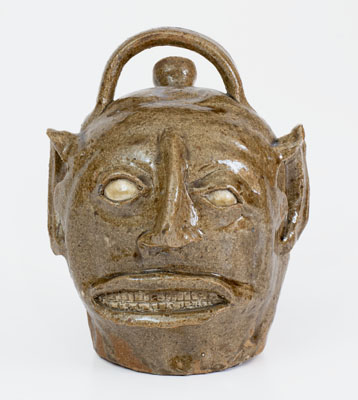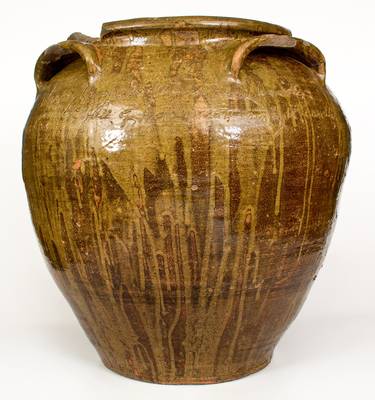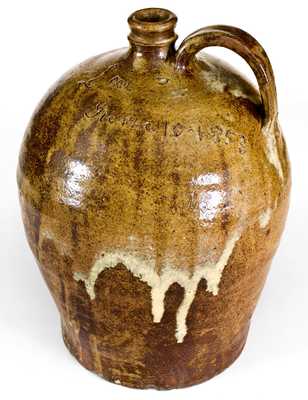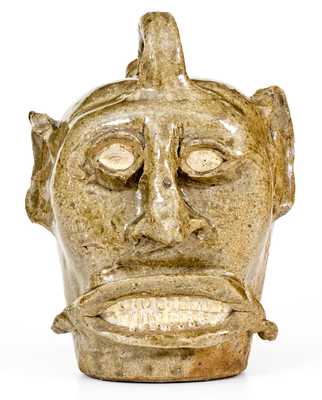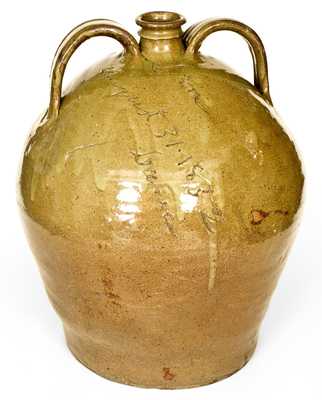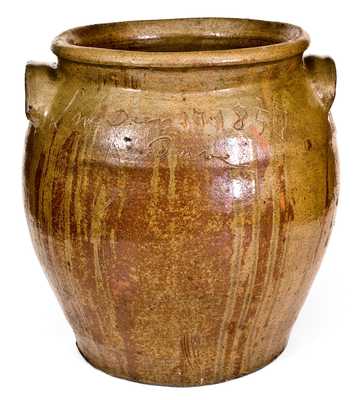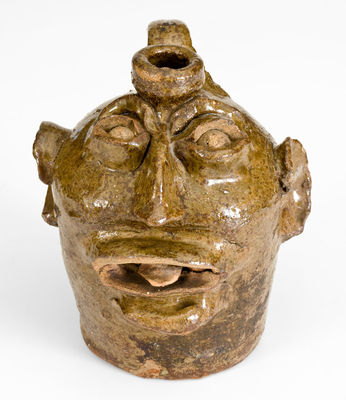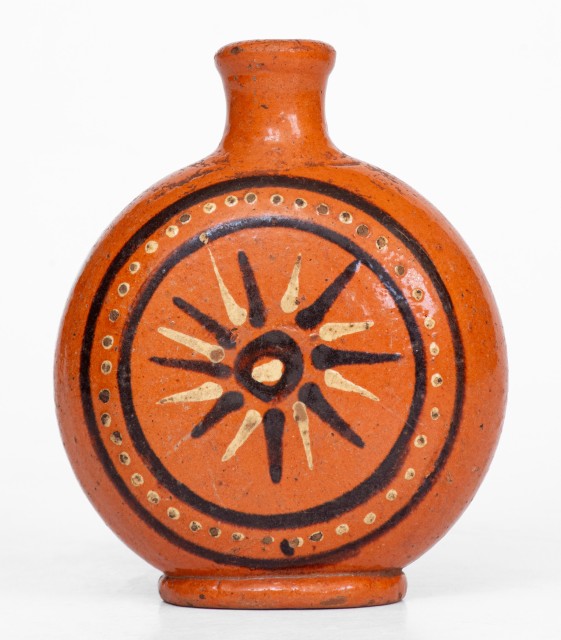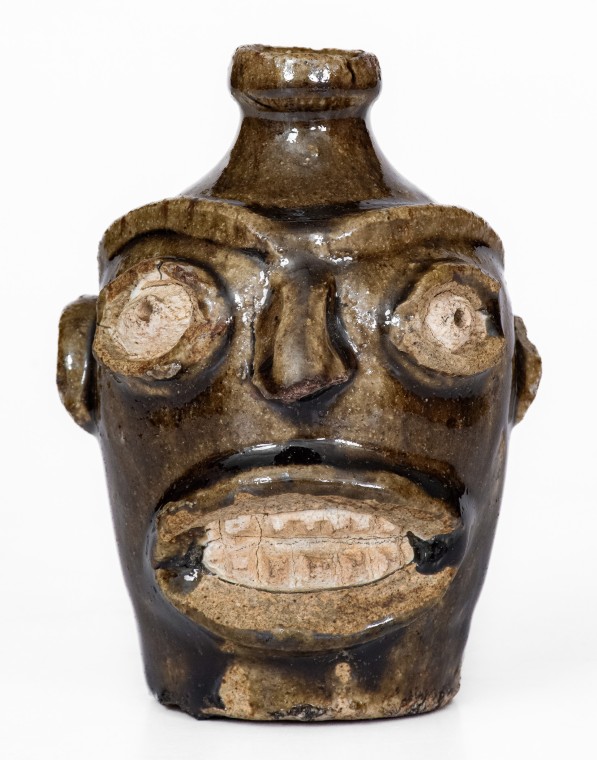Highly Important Large-Sized Alkaline-Glazed Stoneware Face Jar, Stamped "G.P. SEIGLER, / TRENTON, S.C.," George P. Seigler Pottery, Shaw's Creek, Edgefield District, SC, circa 1870-1880, thin-walled, semi-ovoid jar with tooled shoulder, flaring semi-rounded rim, and applied handle on reverse, decorated with a hand-modeled and applied clay face including large eyes, arched eyebrows, well-sculpted Roman nose with carved nostrils, open mouth with individually formed and applied kaolin teeth, prominent cleft chin, and large scrolled ears with orb-shaped tragi. Proper left eye composed of kaolin with pupil drawn in pencil after the firing. Proper right eye appears to be composed of varnished putty or resin, a very old restoration. This restoration was possibly executed at the pottery after the eye was lost during the firing, as such in-the-firing damage was frequent for Edgefield face vessels. Surface covered in a mottled green alkaline glaze. Reverse base impressed with the oval maker's mark, "G.P. SEIGLER / TRENTON, S.C." This newly-discovered Edgefield face vessel is remarkable for its monumental proportions and addition of a maker's stamp, being one of only a few Edgefield examples bearing a signature known. (One bearing the stamp, "CHANDLER / MAKER," made at the pottery of Thomas Chandler circa 1850 and two bearing the stamp, "MARK.," made at the Baynham Pottery in Trenton, circa 1900, have been documented.) This jar, standing an astounding 15 1/4" tall and measuring in the range of four gallons, is outsized among Edgefield face vessels only by the iconic 28" tall face jar in the collection of the High Museum. Parallels can be drawn between the construction of both of these oversized face vessels in the modeling of the vessels' rims as well as the figures' noses and individually-applied, pointed teeth. Adding to the rarity of this example is its jar form. To our knowledge only three total Edgefield face jars are known: the High Museum jar; this jar; and a third, significantly smaller example, illustrated on p. 109 of Cinda K. Baldwin's Great and Noble Jar. The jar offered in this auction is the only example of the three to include a pulled handle on the reverse, designed to aid in carrying the large-sized vessel. Its maker's mark, impressed at the base on the reverse, indicates it was made at the pottery of George P. Seigler, son of John W. Seigler, along Shaw's Creek. According to Baldwin, this mark's Trenton location reflects a change in the post office from Pine House, South Carolina (as seen in John Seigler's earlier stamp) to Trenton, South Carolina, in 1870. The curious addition of this stamp indicates a sense of pride in its manufacture and appears very purposeful considering the fact that, among the two-hundred or so surviving Edgefield face jugs, only three are signed. Could this work perhaps have been a "storefront" advertising piece for Siegler's pottery? Census research discussed by Corbett Toussaint in her 2021-2022 Journal of Early Southern Decorative Arts article, "Edgefield District Stoneware: The Potter's Legacy," shows that, in 1880, the Siegler establishment was operated primarily by four Black potters: Mark Jones; his son, Brister Jones; Fortune Justice; and Washington Miles. Mark Jones is believed to be the son-in-law of David Drake, listed as living in Drake's household along with Brister, his wife, and other children in the 1870 census. His fingerprint has been indelibly left on the story of Edgefield stoneware with the survival of an iconic jar, inscribed "Dave and / Mark / Lm. March 10 1859," in the collection of The Smithsonian Institution. A second famous alkaline-glazed jar by Brister Jones, bearing the incised inscription, “Brister Jones the maker Sept the 6 1880 It will hold inny thing that you can get in it,” bears the same G.P. Seigler, Trenton, SC maker's mark seen on the face jar in this auction and helps place a date on its manufacture. So, while the vast majority of Edgefield face vessels are attributed to unknown potters of African descent from a number of possible shops, this jar can, within reason, be attributed to one of the four men discussed by Toussaint: Mark Jones, Brister Jones, Washington Miles, or Fortune Justice. As such it is one of only two or so Edgefield face vessels that can be attributed with little doubt to a Black potter. (A face jug bearing the incised name, "JOE RANFORD," in the collection of The Smithsonian Institution, is firmly attributed by Toussaint to Fortune Justice based on its distinctive penmanship.) The idea that this work could very well have been made by David Drake's son-in-law or grandson is significant. A combination of several attributes, including size, maker's mark, quality of modeling, form, and glaze, place this jar among the greatest American ceramic face vessels in existence. This exciting discovery not only broadens our understanding of Edgefield's stoneware legacy, but significantly advances our knowledge of the region's captivating and enigmatic face vessels, and the much-studied role of African-American potters in their creation. Additionally, this jar highlights a guild of newly-freed Black potters working in Reconstruction-Era Edgefield District establishing their own identities as craftspeople. Provenance: Recently discovered in the Northeast. Significant loss to rim. Two minor rim chips. A small chip and tiny nick to proper left ear. Two or possibly three teeth missing. Very old restoration to right eye, possibly executed at the pottery. Old white paint drip on handle. H 15 1/8".























